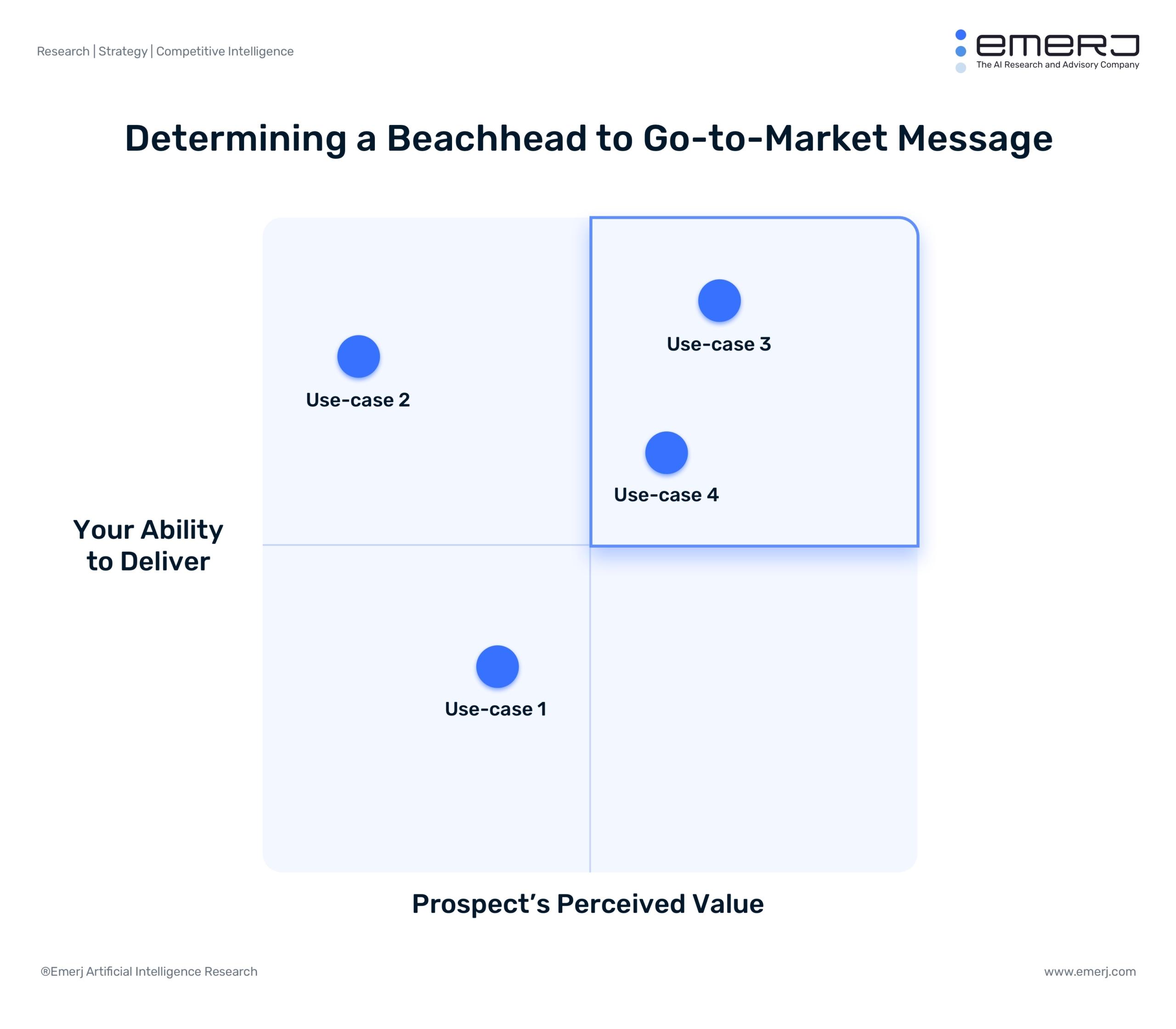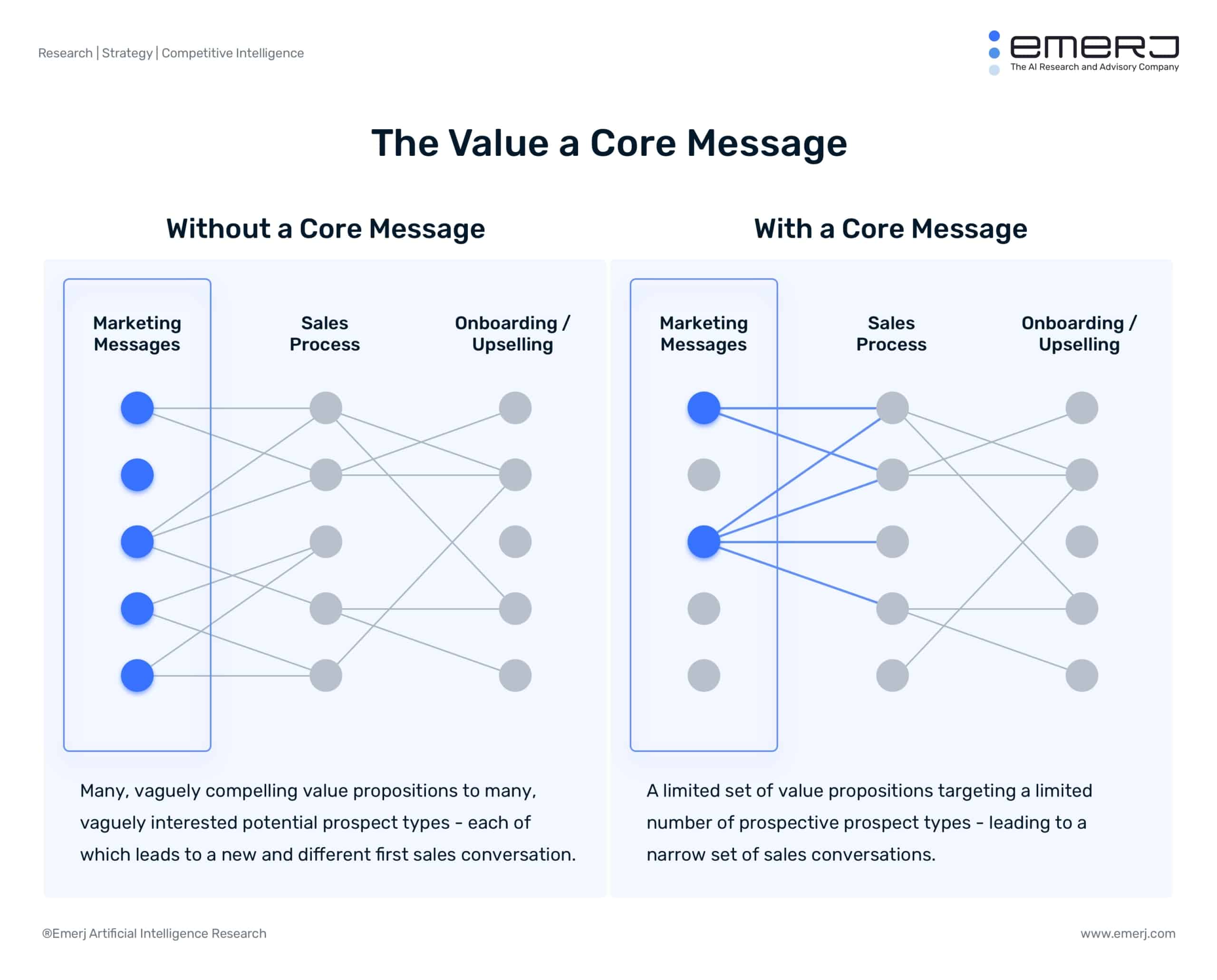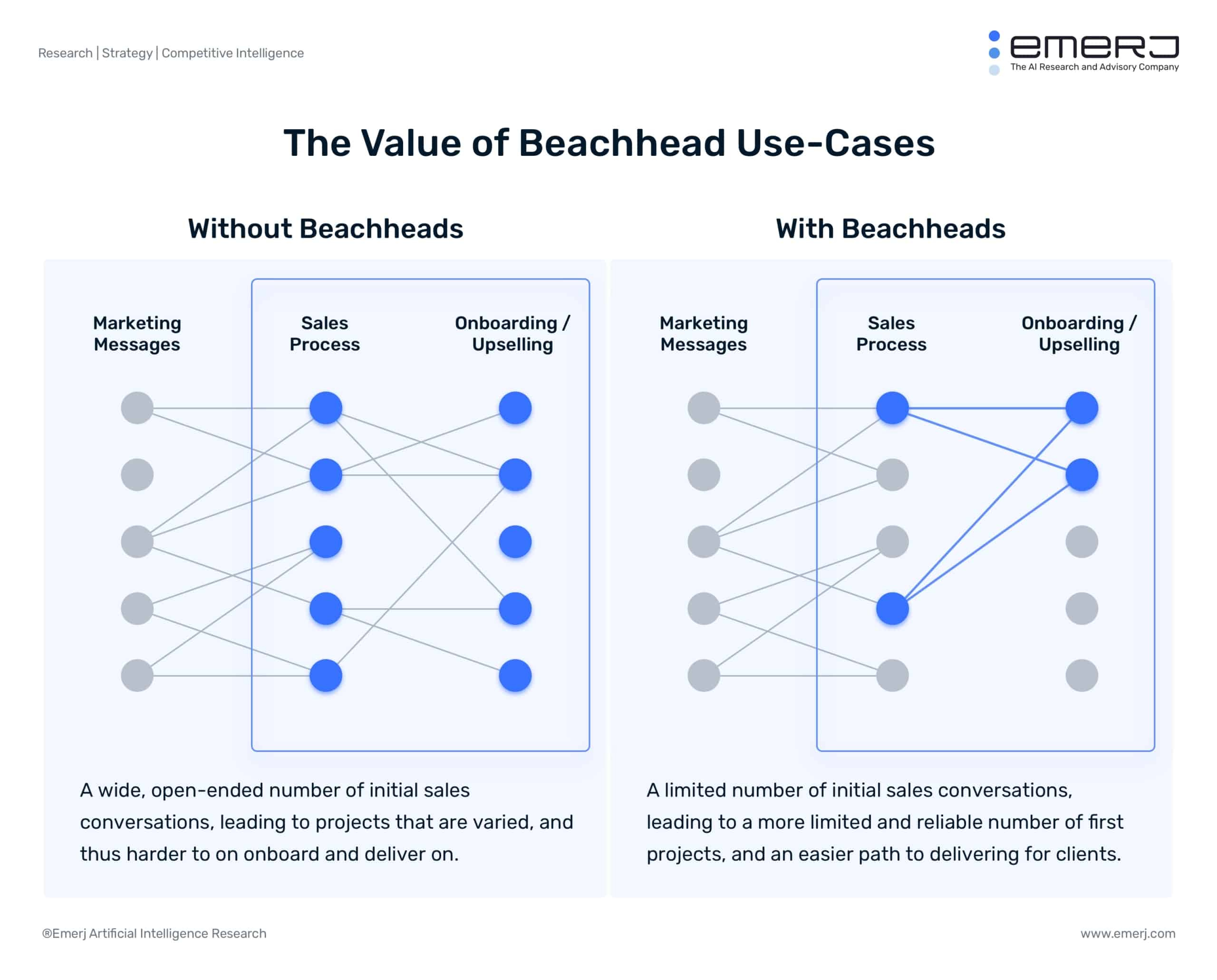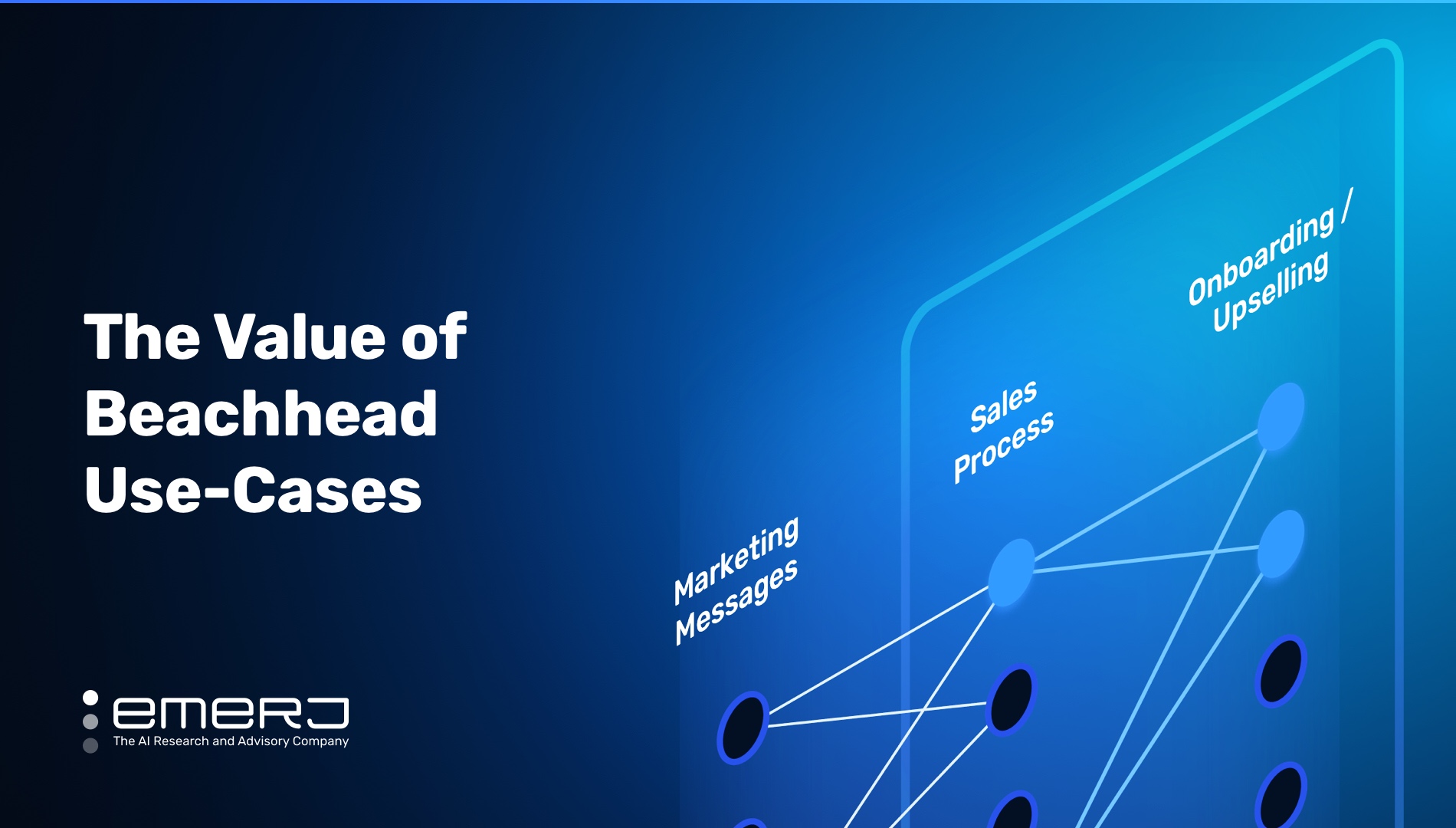Successful AI vendors know that 90% of the value they bring to the table lies in a deep understanding of the client’s context, including:
- The workflow being impacted
- The desires and motives of stakeholders
- Required/common integrations
- The data types likely to be involved
- The unique needs of end-users
“Our AI can be used in any industry” is supreme naiveté, and is stated almost exclusively by marketers who don’t yet know who they serve and how.
The code is easy compared to finding a fruitful business fit – and a prospect type with both need and budget.
Almost any vendor’s technology could work “anywhere.” But the vendors driving value (and winning revenue) know what junctures their tech can fit into, and what users and stakeholders they can reliably deliver value for.
In this article we’ll be discussing the topic of “Beachhead AI Use Cases”, and how we see successful AI vendors leverage use case specificity to create more engaging content, generate better marketing campaigns, and win more business.
This article will be broken out into three sections, each building off the next in a logical progression:
- Determining a Beachhead Go-to-Market Message
- Using a Core Message to Simplify the AI Sale
- Using a Beachhead Use Case to Support an AI Sale
Throughout this series we’ll be touching on previous Emerj Plus articles about the go-to-market process for AI products. We’ll begin by determining a beachhead message:
Determining a Beachhead Go-to-Market Message
We’ll begin with definitions:
- Core Message: A market message with a clear (a) target market (a “who”, which might imply industry, role, etc) and (b) promise to that target market (a “what”, asdf) that reliably generates leads (interest potential prospects) and sales (paying customers).
- Beachhead Use Case: A specific use case that (a) appeals specifically to the pressing (budgeted) needs of a potential customer, and that (b) your firm can actually deliver on reliably.
We encourage AI founders and marketing leaders to think about plotting their potential AI use cases in a matrix:

We also advise marketing teams to focus – whenever possible – on actual traction with customers, not on ungrounded hypotheses. “Traction” could be considered on a continuum:
- Happy Customers – When a deal closes and (a) the engagement was profitable for you as the vendor, and (b) the client is satisfied, that’s the best kind of traction there is.
- Closed Deals – The second best kind of traction is when a deal closes. With many complex AI deployments, closed deals do not end up being wins for the buyer, and may inform the vendor’s leadership to (a) adjust the way they deliver their service or set their expectations of value, or (b) avoid selling that service to that kind of prospect in the future. Most projects take many months to complete this feedback loop, so many closed deals are inconclusive in terms of client value.
- Interest – The least trustworthy form of traction is response to marketing messaging. If a handful of use case driven marketing messages are garnering no response at all, but one or two such messages have lead to qualified sales calls that have turned into real pipeline – that’s a significant signal.
The vast majority of AI firms – even firms who have raised $50-100MM – have few if any happy customers. This isn’t necessarily because the companies don’t deliver value, it’s because winning customers is hard, and many early AI pilot projects won’t ever make their way to deployment.
It’s important to note that different combinations of “deliverables”/”perceived client value” will appeal to different kinds of buyers altogether.
By mapping a number of potential beachhead use cases across the simple matrix above, firms can gain clarity on which prospect types to focus on, and which use cases to go to market with. A smart marketing team will generally not actively test more than three marketing messages concurrently, and will instead focus diligently on either proving or disproving the beachhead use case messages that seem most promising (review our “explore to exploit” market message process in this article).
In the remaining sections of this article, we’ll explore how a tight, deliberately chosen set of marketing messages leads to a more clear sales interaction – and how carefully selected beachhead use cases lead to better sales interactions and customer on-boarding.
Using a Core Message to Simplify the AI Sale

We’ll start my explaining the graphic above:
- Without a Core Message: A vendor firm is mired in a hundred, muddled market messages – achieving only lukewarm resonance with a scattered audience who may or may not be able to become real customers. Sales interactions are also much less predictable – one minute a salesperson could be talking to a CMO, the next minute a Head of Data Science. One minute a salesperson could be touting the technical benefits of the firm’s NLP capabilities, the next minute he/she is touting the workflow impact for contract search and discovery. This kind of context swinging requires an unrealistic amount of contextual understand on the part of the salesperson, and often prevents a salesperson from accurately determining the product they’re truly selling.
- With a Core Message: A vendor firm goes to market with a succinct core message, then they’re not only able to more quickly test/validate their market message ideas, they’re also able to set up their salespeople for more reliable and consistent conversations.
The market message of AI vendor firms evolve predictably as their product gains traction – and they gain real-world experience with actual customers.
No Traction: “We unlock the power of NLP in 15 industries!”
A Few Pilots: “We help with X, Y, and Z NLP applications in these 4 industries”
Profitable: “We reduce X risk in Y and Z specific business functions in 2 industries”
If you see a firm touting a “No Traction”-type message, that probably means what you think it means: They don’t have a genuine sense of what kinds of clients they help with what kinds of problems.
Now, we’ll connect this idea to the graphic below:
Using a Beachhead Use Case to Support an AI Sale

Just as a clear market message helps to set up salespeople to have more consistent, coherent buyer conversations – a strong set of beachhead use cases sets up salespeople to not only have more consistent conversations, but it also allows for a more consistent on-boarding of new customers.
When beachhead use cases are not defined:
- Salespeople have to diagnose the AI use case, business value, and workflow impact of each new prospect – a task that is far too challenging.
- The deals we sell will be wildly divergent and unique for each client – which not only slows down our on-boarding process, but also decreases the likelihood that we’ll reliably delivery value on closed deals.
When strong beachhead use cases are defined:
- Salespeople can come prepared with a handful of solid use cases that (a) they understand well, and (b) they know how to communicate to business leaders. More trust and more resonance with real client problems generally equals more deals.
- The deals we close are more likely to tie to specific, concrete use cases where we have experience and practice – allowing us to more reliably on-board customers and deliver value (i.e. retain customers long-term).
It isn’t uncommon for firms who have raised $50MM+ to launch new products with only vague hypotheses about who will actually buy and use it – and what value it will deliver.
Firms eventually realize that while their tech can “do everything” there are only a handful of use cases where their solution genuinely meets with a burning customer need. Yes, most firms go through a phase of taking all the pilot projects and deals they can to flesh out their understanding of the product, but this should quickly congeal into a focused set of problems to solve, buyers to appeal to, and market messages that make those problem clear to those buyers.
Plus, when a vendor lands 2-3 sales for the same use case, that builds contextual knowledge and social proof, giving that more narrow “beachhead” use case more momentum. This is not limiting, this is a good thing.
Firms that are mature tell you about the wide-sweeping capabilities of their tech only after your attention is hooked by an actual problem you have.
The bad news: Firms who just go out and try to sell “broad capabilities” forever flounder consistently.
The good news: Firms who know that their goal is to iterate and find a resonant market message are more likely to arrive at one sooner, and begin building pipeline sooner.
In Summary
AI firms that discover their “beachheads” grow much faster than those that don’t.
The complaint I hear: “But Daniel, our AI technology can be used for hundreds of workflows, and in many industries.”
Sure, I suppose that might be true.
However, when we see AI firms grow, we see them making most of their sales in 1 or 2 industries – and within those industries – in 1 or 2 key workflows/use cases.
By focusing on those early areas of traction (beachhead), firms gain three absolutely crucial advantages:
- First, their marketing message can be much more focused and understandable
- Second, their salespeople don’t have to be trained on 1000 word tracks, they simply need to understand a handful of key use cases
- Third, a firm can onboard clients and deliver value to them faster when it’s a known use case, not a new and novel use case
That latter point – the importance of specific insights into the workflow and the stakeholders of a specific deployment – is drastically underestimated by inexperienced AI startup founders and marketers.





















